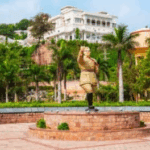
Living Out of a Backpack: Essential Packing Tips for Long-Term Travelers

Embarking on a long-term travel adventure is an exhilarating experience. The freedom of the open road, the thrill of discovering new cultures, and the joy of living with less are all part of the allure. However, one of the biggest challenges for long-term travelers is learning how to pack efficiently. Living out of a backpack requires careful planning, thoughtful selection of items, and a few clever space-saving hacks. In this detailed guide, we’ll cover essential packing tips for long-term travelers, ensuring that you’re well-prepared for your journey without being weighed down.
The Philosophy of Minimalism in Long-Term Travel
Before diving into the specifics of what to pack, it’s important to understand the philosophy of minimalism that underpins efficient packing. When you’re living out of a backpack, every item you carry must serve a purpose. The goal is to travel light while still having everything you need to be comfortable, safe, and prepared for various situations.
A 2022 survey by Hostelworld found that 67% of long-term travelers regretted overpacking, with many reporting that they only used about 60% of the items they brought along. This statistic highlights the importance of being selective and thoughtful about what you include in your backpack.
Choosing the Right Backpack
The foundation of efficient packing starts with selecting the right backpack. For long-term travel, a backpack that’s durable, comfortable, and well-organized is crucial. Here are some factors to consider:
- Size: A 40-60 liter backpack is generally sufficient for most long-term travelers. This size strikes a balance between capacity and portability, allowing you to carry essential items without becoming too cumbersome.
- Fit: Your backpack should be well-fitted to your body to ensure comfort during extended periods of wear. Look for adjustable straps, padded shoulder straps, and a waist belt to distribute weight evenly.
- Compartments: A backpack with multiple compartments and pockets helps with organization. Look for a bag with easy access to the main compartment, as well as side pockets and a front-loading design for convenience.
Must-Have Items for Long-Term Travel
When living out of a backpack, it’s essential to focus on items that are versatile, lightweight, and compact. Below is a list of must-have items that every long-term traveler should consider:
- Clothing:
- Layering Pieces: Opt for lightweight, moisture-wicking clothing that can be layered. This includes a base layer, mid-layer (like a fleece or light sweater), and a waterproof outer layer.
- Multi-Purpose Items: Consider clothing that can serve multiple functions, such as convertible pants, a scarf that doubles as a blanket, or a sarong that can be used as a beach towel.
- Quick-Dry Fabrics: Choose fabrics that dry quickly, which is particularly useful for hand washing and dealing with varying climates.
- Footwear: A pair of sturdy walking shoes, lightweight sandals, and possibly a pair of flip-flops are typically sufficient. Avoid overpacking footwear, as it takes up significant space.
- Toiletries:
- Solid Alternatives: Consider solid shampoo bars, toothpaste tablets, and deodorant sticks to save space and avoid liquid restrictions.
- Compact Containers: Use small, refillable containers for liquids and creams. Keep in mind the 100ml limit for carry-on luggage if you’re flying.
- Microfiber Towel: A quick-drying microfiber towel is essential for travelers. It’s lightweight, compact, and dries much faster than a regular towel.
- Technology:
- Universal Adapter: A universal travel adapter with multiple USB ports can be a lifesaver, allowing you to charge multiple devices simultaneously.
- Portable Power Bank: A high-capacity power bank ensures your devices stay charged, especially during long travel days or when you’re away from power sources.
- Lightweight Laptop/Tablet: If you need to work or stay connected, consider a lightweight laptop or tablet. Ensure it’s well-protected with a durable case.
- Travel Essentials:
- Packing Cubes: These are essential for keeping your backpack organized. They help compress clothing and other items, maximizing space.
- Compression Sacks: Use compression sacks for bulky items like jackets or sleeping bags. They reduce the volume of these items significantly.
- First Aid Kit: A small, travel-sized first aid kit with essentials like band-aids, antiseptic wipes, pain relievers, and any necessary prescription medications is crucial.
- Travel Document Organizer: Keep your passport, travel insurance, tickets, and other important documents organized and easily accessible.
Space-Saving Hacks
Maximizing space in your backpack is an art form. Here are some tried-and-true space-saving hacks that can make a big difference:
- Rolling vs. Folding: Rolling your clothes instead of folding them not only saves space but also reduces wrinkles. This technique is particularly effective for t-shirts, pants, and other non-bulky items.
- Wear Your Bulkiest Items: When traveling, especially by air, wear your bulkiest clothing items, such as your jacket or hiking boots. This frees up valuable space in your backpack.
- Utilize Every Inch: Use every bit of space in your backpack. Stuff socks into shoes, fill gaps with small items, and use the space inside hats or containers for extra storage.
- Dual-Purpose Items: Opt for items that serve multiple purposes. For example, a sarong can be used as a beach towel, blanket, or even a makeshift curtain.
- Decant and Minimize: Decant liquids into smaller containers and carry only what you’ll need. Minimize the number of items by opting for multi-use products, such as a combined shampoo and body wash.
Staying Organized on the Road
Once you’ve packed your backpack, staying organized on the road is key to maintaining efficiency and reducing stress. Here are some tips:
- Develop a Routine: Create a packing routine so that you always know where your items are. This can help prevent losing things and make unpacking and repacking quicker and easier.
- Use Ziploc Bags: Ziploc bags are great for organizing small items like toiletries, chargers, and accessories. They also keep things waterproof and are easy to replace.
- Regularly Review and Adjust: As you travel, periodically review what you’re carrying. If you find that you’re not using certain items, consider sending them home or donating them to lighten your load.
Adjusting Your Packing for Different Climates
Long-term travel often involves moving between different climates, which can complicate packing. Here’s how to adjust your packing strategy:
- Cold Climates: For colder destinations, focus on layering. Merino wool is an excellent choice for base layers as it’s warm, lightweight, and odor-resistant. A compact down jacket can provide warmth without taking up much space.
- Warm Climates: In warmer regions, lightweight, breathable fabrics are essential. Stick to natural fibers like cotton or linen, which help keep you cool. A wide-brimmed hat and sunscreen are also crucial for sun protection.
- Rainy Seasons: Pack a lightweight, packable rain jacket and a small umbrella for wet climates. Quick-drying clothes and waterproof bags can also be very useful.
Conclusion
Living out of a backpack as a long-term traveler is both a challenge and an art form. It requires careful planning, a commitment to minimalism, and a willingness to adapt along the way. By choosing the right backpack, packing versatile and essential items, and employing space-saving hacks, you can set yourself up for a successful and enjoyable journey. Remember, the key to efficient packing is not just about what you bring, but also how you bring it. With the right mindset and approach, you can travel light and live large, experiencing the world without the burden of excess baggage.
Hello, I am Aman (: Full Time Traveler :) At the age of 41, in April 2023, fueled by my love for travel and the determination not to remain fixed like a tree, I embarked on a bold journey. Having dedicated 17 years to a corporate job, I chose to transition from a full-time employee to a full-time traveler, driven by the desire to break free from the routine and constraints of a conventional life. Along the way, I not only explored the wonders of travel but also uncovered the transformative power of financial freedom. I realized how it could liberate me to lead a life teeming with adventure, purpose, and fulfillment. Through my blogs, I am passionately sharing my story, aiming to inspire and provide valuable guidance to those, like me, who aspire to weave travel into a life overflowing with limitless possibilities.






















Post Comment
You must be logged in to post a comment.